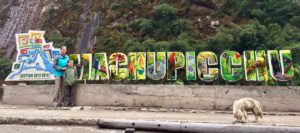By: MJ + PJ
Machu Picchu was all it was cracked up to be and more. Wouldn’t you know it? Getting there from Cusco is fairly simple if negotiating multiple modes of transport is your thing. We caught a bus to Ollantaytambo, then got on the train, then stayed the night at a hostal, then caught the bus up to the top, then walked the trail down, and then returned on the train and finally acquired a bus (amid mass confusion) back to Cusco by midnight. It was a long two days.

We had a great tour guide, and saw the ruins with an only English speaking tour group. Most of the other local tours we were on had been bilingual tours. While you do get to practice your second language skills and translations, multiple translations can burn up time for looking and exploring while waiting to hear your language. At smaller at a site you have limited time at, this can be frustrating. Fortunately, this was the one site it really helped to have a tour in your native language.

Okey-dokey! Our tour guide had spent some time in Detroit. This aside, he explained the history of the site in context of it being a university of sorts for the elite of the Incas. Many of the artifacts, the site layout, the proportions of building types to terraces, and the restricted and difficult access suggest that Machu Picchu was a place to teach the elite (aka. The gods). Gods are meant to be born all knowing and wise, so it makes a degree of sense that a place to educate the gods be secret was hidden from the lower Inca classes.
The site was still incomplete when it was abruptly abandoned. But not everyone left. A significant number of women stayed to live at the site. Historians suspect this was to protect them from whatever threat had presented. Evidence suggests that these women gradually aged and all passed away. It is thought the women were waiting for the previous habitants to return… in vain.

This, of course, is but one interpretation of what can be seen at Machu Picchu. Since there are no records of what actually went down, there are many inferences to be made. This reality of hypothesizing what transpired in Inca history was spelled out in a quote on a a wall inside the Museo de Historia Regional in Cusco, which we visited the next day. (No photos in the museum, and we didn’t write it down… you’ll find it on the right hand wall of the first exhibit room!)
Interpretations aside, the view from the higher positions of the site itself is worth the ticket there. It’s an impressive panorama. Then there is the engineering – water control, earthquake proofing, stone work, and temple design. The technology they used is mind blowing. There is also the incorporation of astronomical and seasonal elements into both the site and particular structures to appreciate. Keeping with the theme of incorporating animal shapes in their site planning, you might like to explore what animal the Inca shaped at Machu Picchu.

The rocks were sourced on site for building, but the soil had to be brought up from the Sacred Valley area. The Inca had an economy based on agriculture and associated goods. They did not rely on the wheel, nor did they have animals who would help much. As one guide explained: “Put 20kg on an alpaca and it might carry it for you. Put 21kg on an alpaca and it will sit down and it will refuse to stand”. The inca had limited help from their animals and the wheel was useless on much of their terrain, so it was they who carried the loads that built their empire.
This UNESCO Heritage Site was high on our list of places to visit on this adventure, and it was very satisfying to tick it off the list. We would visit here again – to trek along the Inca trail and to climb Huyan Picchu. These were things we had hoped to do, but timing and costs limited our ability to do so on this pass through Peru.
A visit to Machu Picchu should be on your lifetime list. This post could simply have been a single photo – one that we had posted early on this trip. A photo that “really ties the room together”, as some might say:

